2.2E: Exercises - Graphing the Basic Functions
- Page ID
- 48339
\( \newcommand{\vecs}[1]{\overset { \scriptstyle \rightharpoonup} {\mathbf{#1}} } \)
\( \newcommand{\vecd}[1]{\overset{-\!-\!\rightharpoonup}{\vphantom{a}\smash {#1}}} \)
\( \newcommand{\id}{\mathrm{id}}\) \( \newcommand{\Span}{\mathrm{span}}\)
( \newcommand{\kernel}{\mathrm{null}\,}\) \( \newcommand{\range}{\mathrm{range}\,}\)
\( \newcommand{\RealPart}{\mathrm{Re}}\) \( \newcommand{\ImaginaryPart}{\mathrm{Im}}\)
\( \newcommand{\Argument}{\mathrm{Arg}}\) \( \newcommand{\norm}[1]{\| #1 \|}\)
\( \newcommand{\inner}[2]{\langle #1, #2 \rangle}\)
\( \newcommand{\Span}{\mathrm{span}}\)
\( \newcommand{\id}{\mathrm{id}}\)
\( \newcommand{\Span}{\mathrm{span}}\)
\( \newcommand{\kernel}{\mathrm{null}\,}\)
\( \newcommand{\range}{\mathrm{range}\,}\)
\( \newcommand{\RealPart}{\mathrm{Re}}\)
\( \newcommand{\ImaginaryPart}{\mathrm{Im}}\)
\( \newcommand{\Argument}{\mathrm{Arg}}\)
\( \newcommand{\norm}[1]{\| #1 \|}\)
\( \newcommand{\inner}[2]{\langle #1, #2 \rangle}\)
\( \newcommand{\Span}{\mathrm{span}}\) \( \newcommand{\AA}{\unicode[.8,0]{x212B}}\)
\( \newcommand{\vectorA}[1]{\vec{#1}} % arrow\)
\( \newcommand{\vectorAt}[1]{\vec{\text{#1}}} % arrow\)
\( \newcommand{\vectorB}[1]{\overset { \scriptstyle \rightharpoonup} {\mathbf{#1}} } \)
\( \newcommand{\vectorC}[1]{\textbf{#1}} \)
\( \newcommand{\vectorD}[1]{\overrightarrow{#1}} \)
\( \newcommand{\vectorDt}[1]{\overrightarrow{\text{#1}}} \)
\( \newcommand{\vectE}[1]{\overset{-\!-\!\rightharpoonup}{\vphantom{a}\smash{\mathbf {#1}}}} \)
\( \newcommand{\vecs}[1]{\overset { \scriptstyle \rightharpoonup} {\mathbf{#1}} } \)
\( \newcommand{\vecd}[1]{\overset{-\!-\!\rightharpoonup}{\vphantom{a}\smash {#1}}} \)
Exercise \(\PageIndex{1}\)
Match the graph to the function definition.
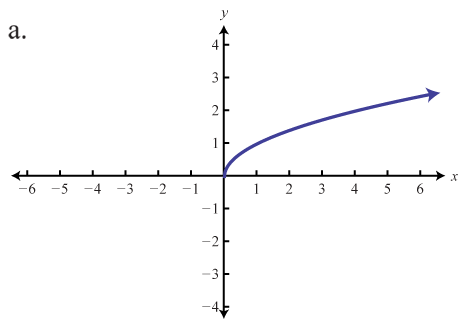
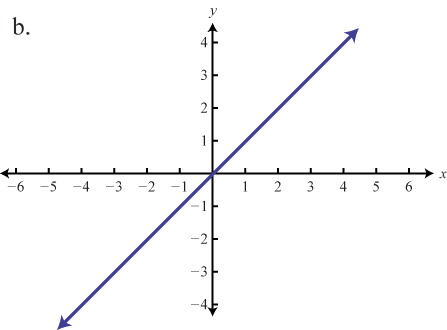
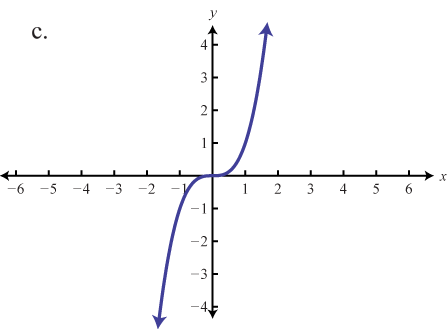
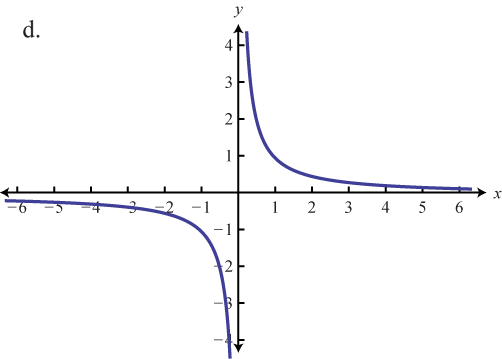
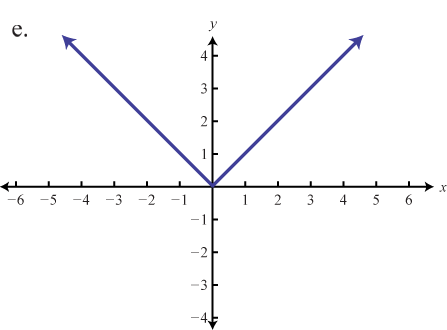
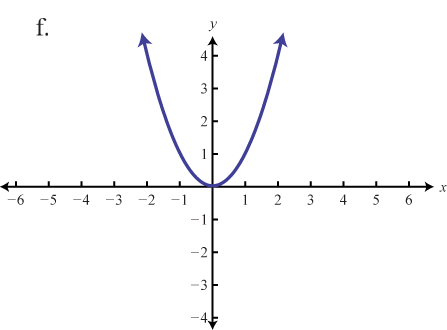
- \(f(x) = x\)
- \(f(x) = x^{2}\)
- \(f(x) = x^{3}\)
- \(f(x) = |x|\)
- \(f(x) = \sqrt{x}\)
- \(f(x) = \frac{1}{x}\)
- Answer
-
1. \(b\)
3. \(c\)
5. \(a\)
Exercise \(\PageIndex{2}\)
Evaluate.
- \(f(x) = x\); find \(f(−10), f(0)\), and \(f(a)\).
- \(f(x) = x^{2}\); find \(f(−10), f(0)\), and \(f(a)\).
- \(f(x) = x^{3}\); find \(f(−10), f(0)\), and \(f(a)\).
- \(f(x) = |x|\); find \(f(−10), f(0)\), and \(f(a)\).
- \(f(x) = \sqrt{x}\); \(find f(25), f(0)\), and \(f(a)\) where \(a ≥ 0\).
- \(f(x) = \frac{1}{x}\); find \(f(−10), f (\frac{1}{5})\), and \(f(a)\) where \(a ≠ 0\).
- \(f(x) = 5\); find \(f(−10), f(0)\), and \(f(a)\).
- \(f(x) = −12\); find \(f(−12), f(0)\), and \(f(a)\).
- Graph \(f(x) = 5\) and state its domain and range.
- Graph \(f(x) = −9\) and state its domain and range
- Answer
-
1. \(f ( - 10 ) = - 10 , f ( 0 ) = 0 , f ( a ) = a\)
3. \(f ( - 10 ) = - 1,000 , f ( 0 ) = 0 , f ( a ) = a ^ { 3 }\)
5. \(f ( 25 ) = 5 , f ( 0 ) = 0 , f ( a ) = \sqrt { a }\)
7. \(f ( - 10 ) = 5 , f ( 0 ) = 5 , f ( a ) = 5\)
9. Domain: \(\mathbb{R}\); range \(\{5\}\)
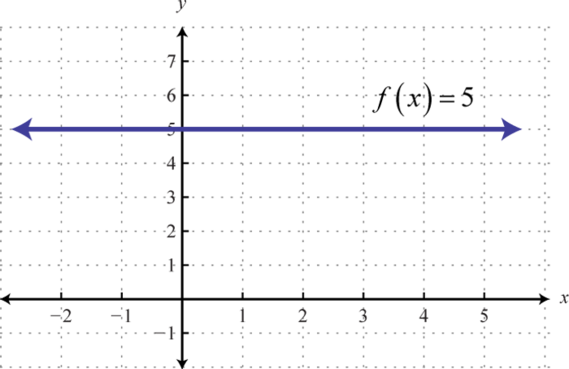
Figure 2.4.23
Exercise \(\PageIndex{3}\)
Cube root function.
- Find points on the graph of the function defined by \(f ( x ) = \sqrt [ 3 ] { x }\) with \(x\)-values in the set \(\{−8, −1, 0, 1, 8\}\).
- Find points on the graph of the function defined by \(f ( x ) = \sqrt [ 3 ] { x }\) with \(x\)-values in the set \(\{−3, −2, 1, 2, 3\}\). Use a calculator and round off to the nearest tenth.
- Graph the cube root function defined by \(f ( x ) = \sqrt [ 3 ] { x }\) by plotting the points found so far.
- Determine the domain and range of the cube root function.
- Answer
-
1. \(\{ ( - 8 , - 2 ) , ( - 1 , - 1 ) , ( 0,0 ) , ( 1,1 ) , ( 8,2 ) \}\)
3.
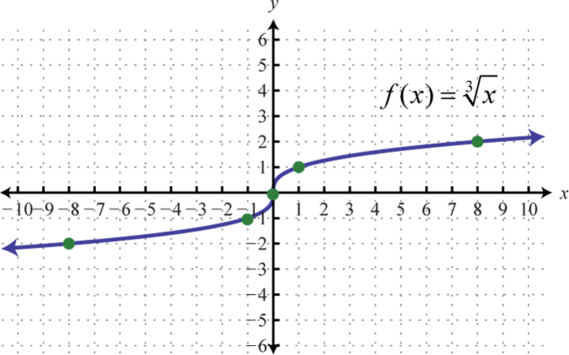
Figure 2.4.24
Exercise \(\PageIndex{4}\)
Find the ordered pair that specifies the point \(P\).
1.
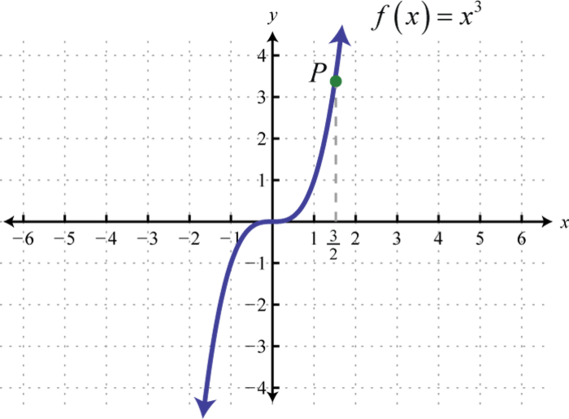
2.
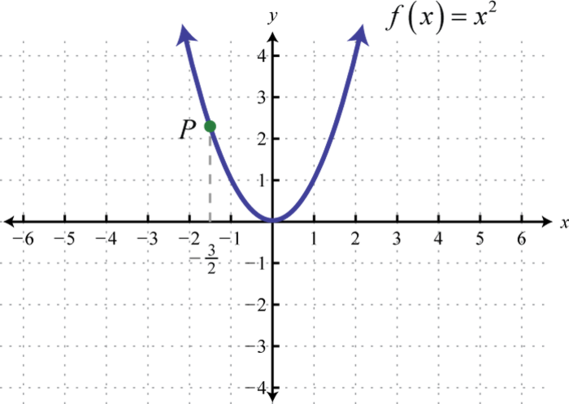
3.
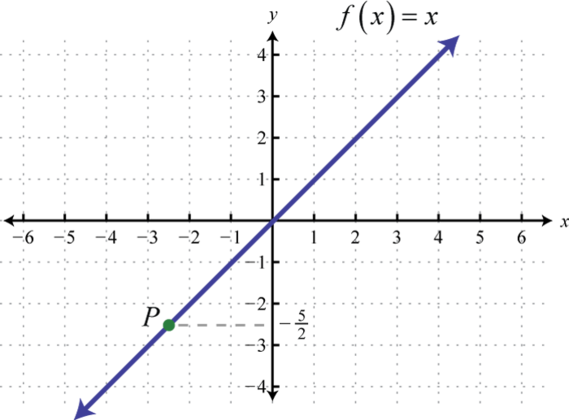
4.
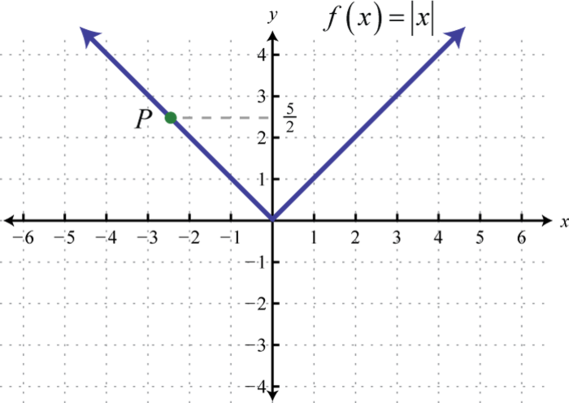
- Answer
-
1. \(\left( \frac { 3 } { 2 } , \frac { 27 } { 8 } \right)\)
3. \(\left( - \frac { 5 } { 2 } , - \frac { 5 } { 2 } \right)\)
Exercise \(\PageIndex{5}\)
Graph the piecewise functions.
- \(g ( x ) = \left\{ \begin{array} { l l } { 2 } & { \text { if } x < 0 } \\ { x } & { \text { if } x \geq 0 } \end{array} \right.\)
- \(g ( x ) = \left\{ \begin{array} { l l } { x ^ { 2 } } & { \text { if } x < 0 } \\ { 3 } & { \text { if } x \geq 0 } \end{array} \right.\)
- \(h ( x ) = \left\{ \begin{array} { l l } { x } & { \text { if } x < 0 } \\ { \sqrt { x } } & { \text { if } x \geq 0 } \end{array} \right.\)
- \(h ( x ) = \left\{ \begin{array} { l } { | x | \text { if } x < 0 } \\ { x ^ { 3 } \text { if } x \geq 0 } \end{array} \right.\)
- \(f ( x ) = \left\{ \begin{array} { l } { | x | \text { if } x < 2 } \\ { 4 \text { if } x \geq 2 } \end{array} \right.\)
- \(f ( x ) = \left\{ \begin{array} { l l } { x } & { \text { if } x < 1 } \\ { \sqrt { x } } & { \text { if } x \geq 1 } \end{array} \right.\)
- \(g ( x ) = \left\{ \begin{array} { l l } { x ^ { 2 } \text { if } x \leq - 1 } \\ { x \quad \text { if } x > - 1 } \end{array} \right.\)
- \(g ( x ) = \left\{ \begin{array} { l } { - 3 \text { if } x \leq - 1 } \\ { x ^ { 3 } \text { if } x > - 1 } \end{array} \right.\)
- \(h ( x ) = \left\{ \begin{array} { l } { 0 \text { if } x \leq 0 } \\ { \frac { 1 } { x } \text { if } x > 0 } \end{array} \right.\)
- \(h ( x ) = \left\{ \begin{array} { l } { \frac { 1 } { x } \text { if } x < 0 } \\ { x ^ { 2 } \text { if } x \geq 0 } \end{array} \right.\)
- \(f ( x ) = \left\{ \begin{array} { l l } { x ^ { 2 } } & { \text { if } x < 0 } \\ { x } & { \text { if } 0 \leq x < 2 } \\ { - 2 } & { \text { if } x \geq 2 } \end{array} \right.\)
- \(f ( x ) = \left\{ \begin{array} { l l } { x } & { \text { if } x < - 1 } \\ { x ^ { 3 } } & { \text { if } - 1 \leq x < 1 } \\ { 3 } & { \text { if } x \geq 1 } \end{array} \right.\)
- \(g ( x ) = \left\{ \begin{array} { l l } { 5 } & { \text { if } x < - 2 } \\ { x ^ { 2 } } & { \text { if } - 2 \leq x < 2 } \\ { x } & { \text { if } x \geq 2 } \end{array} \right.\)
- \(g ( x ) = \left\{ \begin{array} { l l } { x } & { \text { if } x < - 3 } \\ { | x | } & { \text { if } - 3 \leq x < 1 } \\ { \sqrt { x } } & { \text { if } x \geq 1 } \end{array} \right.\)
- \(h ( x ) = \left\{ \begin{array} { l } { \frac { 1 } { x } \text { if } x < 0 } \\ { x ^ { 2 } \text { if } 0 \leq x < 2 } \\ { 4 \text { if } x \geq 2 } \end{array} \right.\)
- \(h ( x ) = \left\{ \begin{array} { l } { 0 \text { if } x < 0 } \\ { x ^ { 3 } \text { if } 0 < x \leq 2 } \\ { 8 \text { if } x > 2 } \end{array} \right.\)
- \(f ( x ) = [\left[\!\![x+0.5]\!\!\right]\)
- \(f(x) = \left[\!\![x]\!\!\right] +1\)
- \(f(x) = \left[\!\![0.5x]\!\!\right]\)
- \(f(x) = 2\left[\!\![x]\!\!\right]\)
- Answer
-
1.
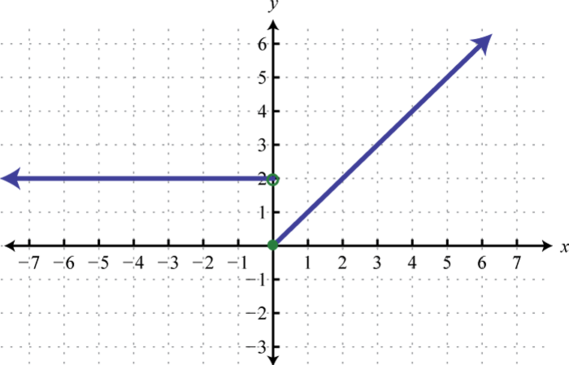
Figure 2.4.29 3.
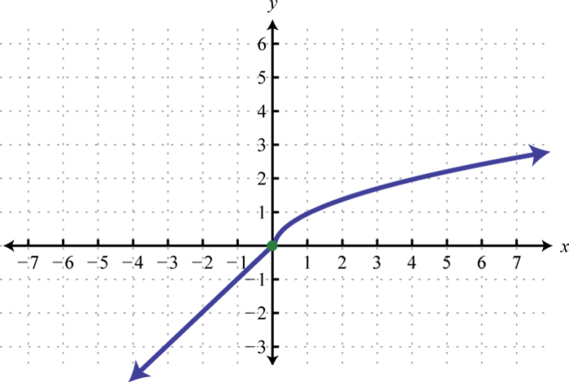
Figure 2.4.50 5.
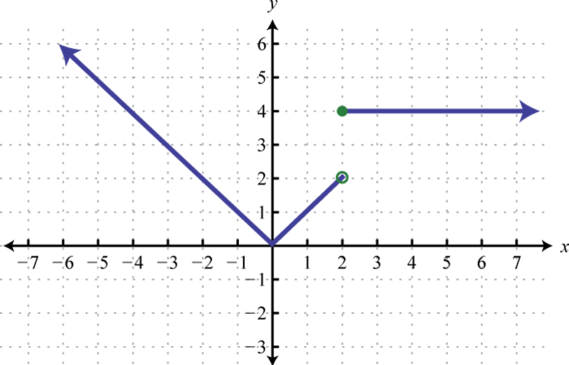
Figure 2.4.51 7.
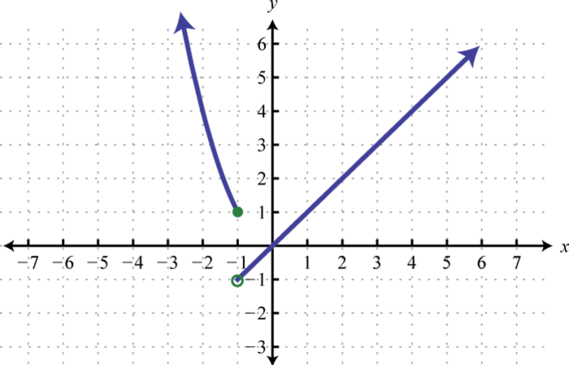
Figure 2.4.52 9.

Figure 2.4.53 11.
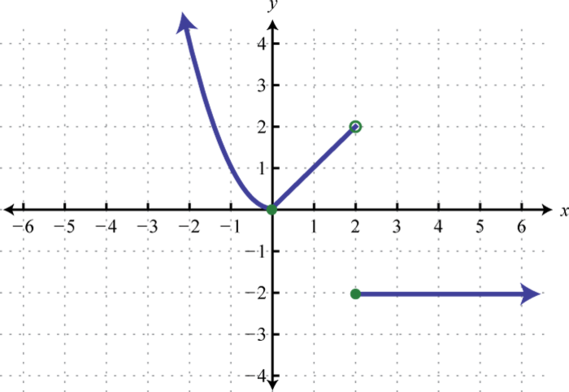
Figure 2.4.54 13.
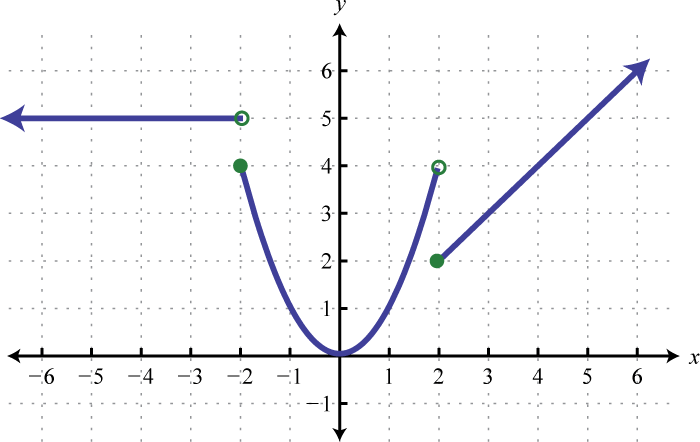
Figure 2.4.55 15.
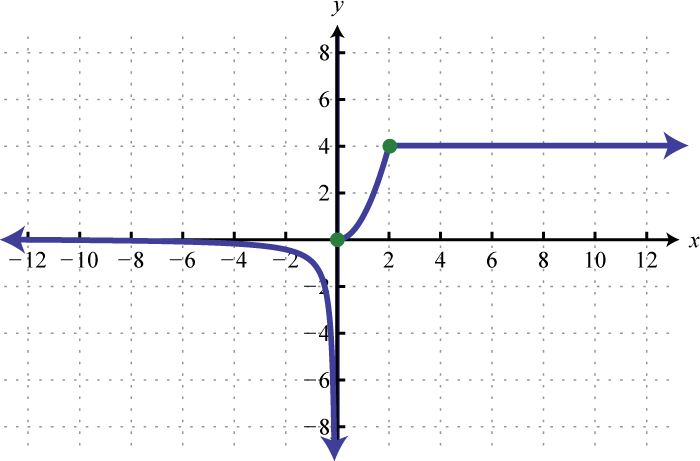
Figure 2.4.56 17.
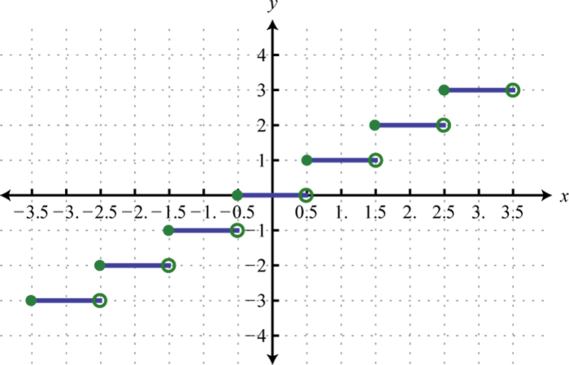
Figure 2.4.57 19.
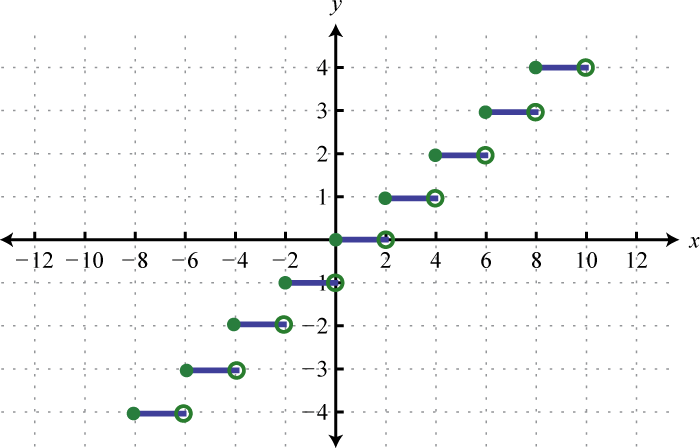
Figure 2.4.58
Exercise \(\PageIndex{6}\)
Evaluate.
1. \(f ( x ) = \left\{ \begin{array} { l l } { x ^ { 2 } } & { \text { if } x \leq 0 } \\ { x + 2 } & { \text { if } x > 0 } \end{array} \right.\)
Find \(f(-5), f(0)\), and \(f(3)\).
2. \(f ( x ) = \left\{ \begin{array} { l l } { x ^ { 3 } } & { \text { if } x < 0 } \\ { 2 x - 1 } & { \text { if } x \geq 0 } \end{array} \right.\)
Find \(f(−3), f(0)\), and \(f(2)\).
3. \(g ( x ) = \left\{ \begin{array} { l l } { 5 x - 2 } & { \text { if } x < 1 } \\ { \sqrt { x } } & { \text { if } x \geq 1 } \end{array} \right.\)
Find \(g(−1), g(1)\), and \(g(4)\).
4. \(g ( x ) = \left\{ \begin{array} { l } { x ^ { 3 } \text { if } x \leq - 2 } \\ { | x | \text { if } x > - 2 } \end{array} \right.\)
Find \(g(−3), g(−2)\), and \(g(−1)\).
5. \(h ( x ) = \left\{ \begin{array} { l l } { - 5 } & { \text { if } x < 0 } \\ { 2 x - 3 } & { \text { if } 0 \leq x < 2 } \\ { x ^ { 2 } } & { \text { if } x \geq 2 } \end{array} \right.\)
Find \(h(−2), h(0)\), and \(h(4)\).
6. \(h ( x ) = \left\{ \begin{array} { l } { - 3 x \text { if } x \leq 0 } \\ { x ^ { 3 } \text { if } 0 < x \leq 4 } \\ { \sqrt { x } \text { if } x > 4 } \end{array} \right.\)
Find \(h(−5), h(4)\), and \(h(25)\).
7. \(f ( x ) = \left[\!\![x-0.5]\!\!\right]\)
Find \(f(−2), f(0)\), and \(f(3)\).
8. \(f ( x ) = \left[\!\![2x]\!\!\right] + 1\)
Find \(f(−1.2), f(0.4)\), and \(f(2.6)\).
- Answer
-
1. \(f (−5) = 25, f(0) = 0\), and \(f(3) = 5\)
3. \(g(−1) = −7, g(1) = 1\), and \(g(4) = 2\)
5. \(h(−2) = −5, h(0) = −3\), and \(h(4) = 16\)
7. \(f(−2) = −3, f(0) = −1\), and \(f(3) = 2\)
Exercise \(\PageIndex{7}\)
Evaluate given the graph of \(f\).
1. Find \(f(-4), f(-2)\), and \(f(0)\).
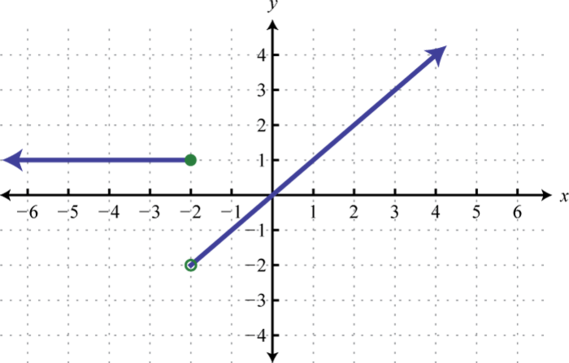
2. Find \(f(−3), f(0)\), and \(f(1)\).
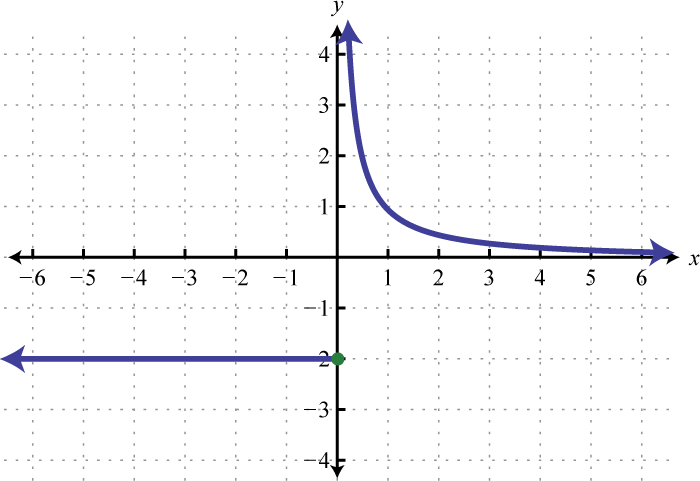
3. Find \(f(0), f(2)\), and \(f(4)\).
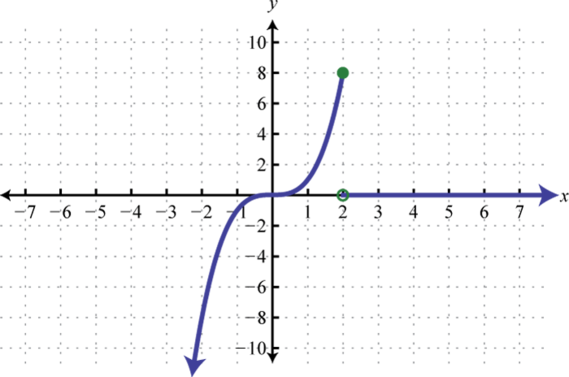
4. Find \(f(−5), f(−2)\), and \(f(2)\).
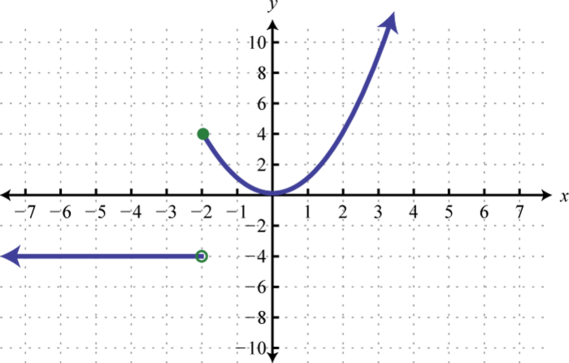
5. Find \(f(−3), f(−2)\), and \(f(2)\).

6. Find \(f(−3), f(0)\), and \(f(4)\).
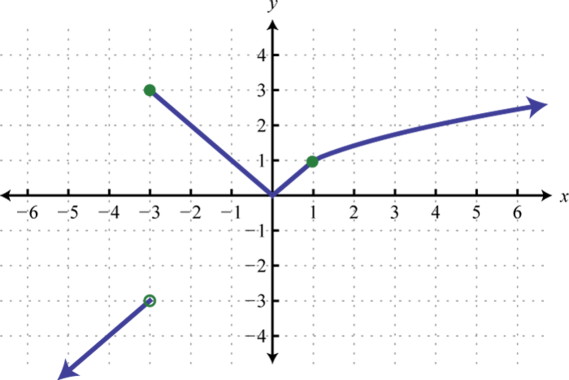
7. Find \(f(−2), f(0)\), and \(f(2)\).
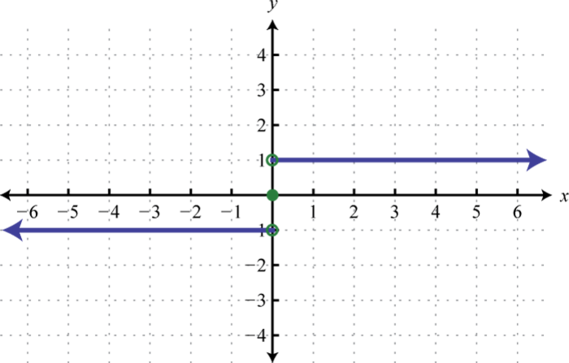
8. Find \(f(−3), f(1)\), and \(f(2)\).
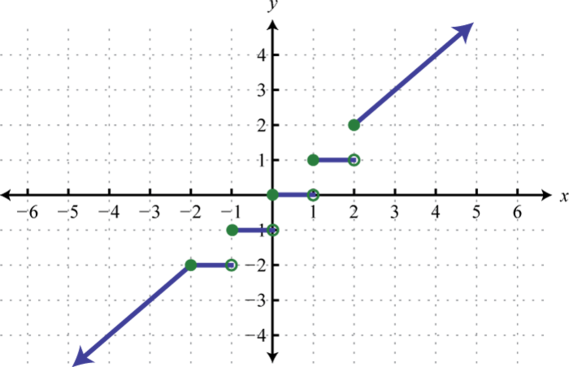
9. The value of an automobile in dollars is given in terms of the number of years since it was purchased new in \(1975\):
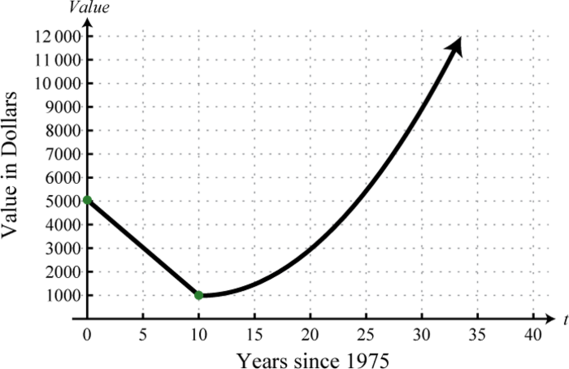
(1) Determine the value of the automobile in the year \(1980\).
(2) In what year is the automobile valued at \($9,000\)?
10. The cost per unit in dollars of custom lamps depends on the number of units produced according to the following graph:
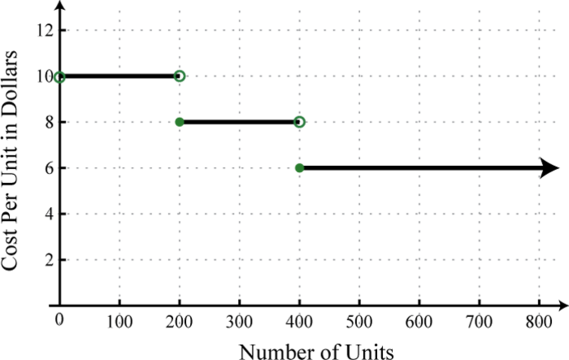
(1) What is the cost per unit if \(250\) custom lamps are produced?
(2) What level of production minimizes the cost per unit?
11. An automobile salesperson earns a commission based on total sales each month \(x\) according to the function:
\(( x ) = \left\{ \begin{array} { l l } { 0.03 x\quad \text { if } \quad 0 \leq x < \$ 20,000 } \\ { 0.05 x \quad\text { if } } \quad { \$ 20,000 \leq x < \$ 50,000 } \\ { 0.07 x \quad\text { if } }\quad { x \geq \$ 50,000 } \end{array} \right.\)
(1) If the salesperson’s total sales for the month are \($35,500\), what is her commission according to the function?
(2) To reach the next level in the commission structure, how much more in sales will she need?
12. A rental boat costs \($32\) for one hour, and each additional hour or partial hour costs \($8\). Graph the cost of the rental boat and determine the cost to rent the boat for \(4 \frac{1}{2}\) hours.
- Answer
-
1. \(f(−4) = 1, f(−2) = 1\), and \(f(0) = 0\)
3. \(f(0) = 0, f(2) = 8\), and \(f(4) = 0\)
5. \(f(−3) = 5, f(−2) = 4\), and \(f(2) = 2\)
7. \(f(−2) = −1, f(0) = 0\), and \(f(2) = 1\)
9. (1) \($3,000\); (2) \(2005\)
11. (1) \($1,775\); (2) \($14,500\)

